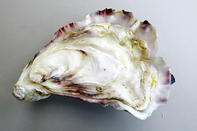Oysters are filter-feeding bi-valved - double-shelled - water snails or molluscs, with rough and scaly shells, oval to pear-shaped. Being filter feeders means oysters remove phytoplankton from seawater and convert it into edible protein.

Their preferred habitats are rocks, shells or debris in seawater and in estuaries, where they can be found up to 40 m deep. These ugly ‘snails’ are considered a seafood delicacy and are mostly eaten raw.
According to the Aquaculture Yearbook 2016 produced by Department of Agriculture, Forestry and Fisheries (DAFF), oyster farming contributed 8% of South Africa’s total marine aquaculture production of about 3 600 tonnes in 2015. In 2018, about 500 tonnes of oysters were produced, mostly from Saldanha Bay on South Africa’s West Coast but also from Nelson Mandela Bay near Port Elizabeth.
History of Oyster Farming
While oyster farming started in Japan centuries ago already, it was only introduced to the West in the 20th century, it started in the USA in the 1920s and in France in the 1960s. Now, international farmed production of oysters is around 600 000 tonnes per year, mostly produced in the Republic of Korea, France and, of course, in Japan.
In South Africa, efforts to produce oysters started in the late 1600s, when European settlers unsuccessfully attempted to farm the native Cape rock oyster, along the Cape coast. Importing and farming both the non-native European flat oyster and Portuguese oyster in the 1940s were also unsuccessful.
In the 1950s South Africa eventually imported the globally farmed Pacific oyster and introduced a batch of spat or ‘baby oysters’ to the Knysna estuary. Today, the only oyster species farmed in South Africa is the non-native Pacific oyster, Crassostrea gigas, traditionally farmed in Japan.
Oyster Species for Farming
The Pacific oyster, Crassostrea gigas, is the most widely cultivated oyster in the world because of its fast growth rate, reaching a marketable size within 24 months.
Within South Africa, self-sustaining populations of Pacific oysters are only found in estuaries such as in Knysna, with no marine populations. Water temperatures along the South African coast range from 8° - 18°C on the West Coast, 15° - 22°C on the South Coast and 22°- 27°C along the East Coast.
The Pacific oyster can tolerate a wide temperature range from -2° to 35°C, but for optimal reproduction temperatures over 20°C are required. This may explain why there appear to be no self-sustaining populations of Pacific oysters on the West Coast and why oyster farming in this region requires continuous seeding in order to be sustainable.
No evidence for hybridization between indigenous South African oysters and Pacific oyster has been found.
By Marinda Louw